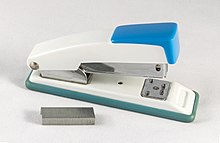Stapling
A stitching is a fastening, in the narrower sense in particular one that is sewn. The underlying verb heften is used in German as early as 8th century Old High German. The verb is a Faktitivum for used also for the Old High German adjective way "trapped, bound". In the Middle Ages, a surgical suture was called detention, and sewing a wound was called stapling .
The concept of stapling as a (only) point-like connection can be found in addition to sewing, for example, when fixing metal parts with individual welding points. Pointed connections also provide the staple and the thumbtack (thumbtack).
The stitching of books happened originally, like sewing, by a stitching thread or stitching yarn . In this context, the sewing needle is a bookbinder's needle . This stitching is still used today and is called thread stitching . The term booklet in the meaning of "writing book" originated in the 16th century as a regression to staple and in this respect means "the stapled". The binding margin is a left free margin on letterhead and printed paper.
Staples
A stapler or a Heftmappe is a file folder for documents (paper). With a few exceptions (see Badische Filing ), filing files , hanging files or loose-leaf binders are used today. When filing documents, a distinction is made between:
- Commercial stapling : The current document is on top and the older documents follow chronologically below.
- Official or authority stapling : The oldest document at the top, the newest documents are attached to the end of the file.
Stapling
When stapling, the mostly U-shaped staple is bent over on the two legs so that they come to rest roughly parallel to the back of the staple. Depending on the stapling method, the staple legs protrude in a semicircle or lie flat. The two staple legs thereby encompass the material to be stapled, such. B. Paper, cardboard, leather, etc. Continuous staples and blind staples are known. With continuous stapling, the staple is folded outside, with blind stapling inside the material to be stapled. Blind stapling is used when stapling cardboard boxes.
The staple is usually bent on a stapling anvil or by so-called bending grippers. Correspondingly pre-formed staples are also known, which bend automatically as soon as the deformation is carried out with a driver.
Different sizes are common for staples.
In addition to the staple adhesion, there is also eyelet fastening . Here the documents to be connected are perforated and a metal eyelet is used, the edges of which are pressed into the material to be stapled. Eyelet staplers work with separate holes and “loops” or in a complete operation.
Eyelet staples can hardly be opened without damaging the stapled material. The eyelet is suitable for a thread with a seal. Eyelet stitching is preferred by offices, authorities, lawyers and notaries when documents are to be combined into a single unit.
Regardless of whether brackets or eyelets are used, documents should be attached to the upper left corner that is turned back. This strengthens the stapling and enables the pages to be easily turned over when studying the document after removing it from a binder or folder.
Stapling is in contrast to nailing or stapling . When nailing or stapling, the staple is pressed or shot unbent into the material and remains there in a U-shape. This method is mainly used to nail materials or to join wood or the like.
See also
References and footnotes
- ↑ a b c Lutz Mackensen: Large German Dictionary . Stuttgart 1977.
- ↑ a b Kluge Etymological Dictionary of the German Language , 24th edition, 2002
- ↑ Dieter Lehmann: Two medical prescription books of the 15th century from the Upper Rhine. Part I: Text and Glossary. Horst Wellm, Pattensen / Han. 1985, now at Königshausen & Neumann, Würzburg (= Würzburg medical-historical research. Volume 34), ISBN 3-921456-63-0 , pp. 188 and 190.
- ^ Official journal , accessed on June 16, 2015.
